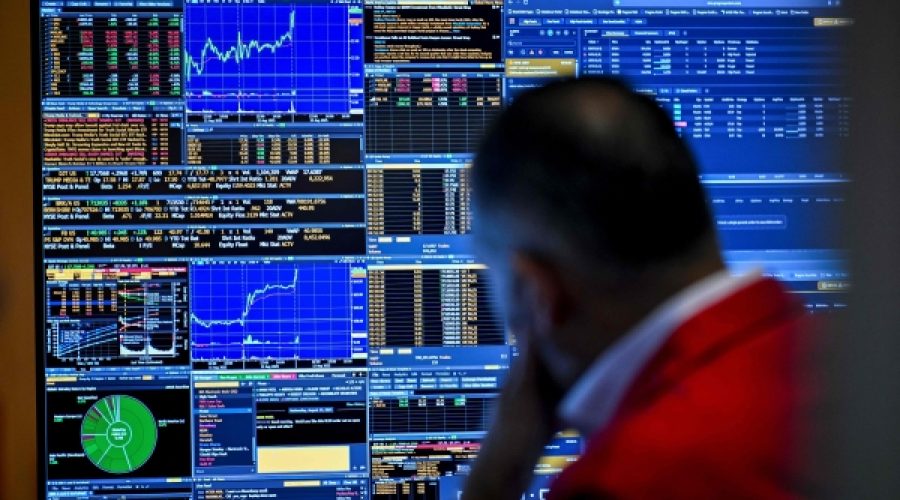زيارة زيلينسكي إلى واشنطن: ما تعنيه لاستقرار السوق العالمية وثقة المستثمرين
شهدت الأسهم الأوروبية والدولار الأمريكي تقلبات يوم الاثنين قبل أسبوع محوري لسياسة أسعار الفائدة الأمريكية، في حين ظلت أسعار النفط منخفضة مع تراجع المخاوف بشأن مخاطر الإمدادات الروسية.
استقر مؤشر ستوكس 600 الأوروبي في معظمه في بداية التداولات بعد أن بلغ أعلى مستوى له منذ مارس يوم الجمعة. في الوقت نفسه، بقي مؤشر MSCI العالمي لجميع الدول قريبًا من أعلى مستوى قياسي حققه الأسبوع الماضي.
خلال الجلسة الآسيوية، دفع الإقبال الحذر على المخاطرة مؤشرات الأسهم في اليابان وتايوان إلى مستويات قياسية. إضافةً إلى ذلك، وصل مؤشر رئيسي للأسهم الصينية إلى أعلى مستوى له في عشر سنوات.
يستعد المستثمرون لاجتماع مهم يوم الاثنين يضم الرئيس الأمريكي دونالد ترامب، والرئيس الأوكراني فولوديمير زيلينسكي، وقادة أوروبيين. ويركز جدول الأعمال على تحديد الخطوات التالية لإنهاء الصراع في أوكرانيا، عقب قمة ترامب مع الرئيس الروسي فلاديمير بوتين في ألاسكا يوم الجمعة الماضي. ورغم عدم التوصل إلى اتفاق في تلك القمة، بدا ترامب أكثر انسجامًا مع موسكو في السعي إلى اتفاق سلام شامل بدلًا من وقف إطلاق نار تمهيدي.
واجه مؤشر الدولار الأمريكي ضغوطًا هذا العام حيث قللت سياسات ترامب الجمركية من جاذبيته كملاذ آمن. ارتفع المؤشر بشكل حاد من أدنى مستوى له عند 95.99 في 1 يوليو إلى ذروة بلغت 100 في 1 أغسطس، مدفوعًا ببيانات اقتصادية قوية واتفاقيات تجارية جديدة، بما في ذلك اتفاقية مع اليابان. منذ ذلك الحين، انخفض إلى 97.78، بانخفاض 2.25% من ذروته، متأثرًا باحتمالية 93% لخفض سعر الفائدة من قبل مجلس الاحتياطي الفيدرالي في سبتمبر وسط ضعف الرواتب وتراجع مبيعات التجزئة. لم ينتج عن اجتماع ترامب مع بوتين أي عقوبات جديدة على روسيا، في حين أن نتيجة اجتماع اليوم مع زيلينسكي قد تؤثر على معنويات الدولار. كما أن ندوة جاكسون هول القادمة يوم الجمعة، وخاصة تعليقات رئيس مجلس الاحتياطي الفيدرالي جيروم باول، متوقعة للغاية لإمكانية تشكيل توقعات السوق.
يستقر مؤشر الدولار حاليًا حول مستوى 97.78 قبيل اجتماع زيلينسكي. وقد تعزز ارتباطه بعوائد سندات الخزانة الأمريكية على مدى 30 يومًا بشكل مطرد منذ أبريل - بعد انقطاع قصير بسبب عدم اليقين بشأن الرسوم الجمركية - مما يشير إلى أن توقعات أسعار الفائدة، وليس معنويات المخاطرة، هي العامل المؤثر. تشمل المستويات الفنية الرئيسية للمؤشر الدعم الفوري عند 97.45 (أدنى مستويات منتصف أغسطس)، ودعمًا إضافيًا عند 96.26، ومقاومة عند 98.46.
انخفضت أسعار النفط بمقدار 1.21 تريليون دولار يوم الاثنين قبل أن تستقر يوم الثلاثاء، حيث يترقب المتداولون اجتماع الولايات المتحدة وروسيا يوم الجمعة لتحديد اتجاهات السوق. وقد تؤدي هذه المحادثات إلى تخفيف العقوبات الأمريكية على روسيا، العضو في أوبك+، مما يزيد المعروض العالمي.
انخفضت أسعار النفط هذا العام مع زيادة أوبك+ إنتاجها رغم مخاوف فائض المعروض، بالإضافة إلى إجراءات الرسوم الجمركية الأمريكية التي أضعفت الطلب العالمي. ويوم الثلاثاء، رفعت وزارة الطاقة الأمريكية توقعاتها لفائض النفط العالمي هذا العام إلى 1.7 مليون برميل يوميًا.
ومن المقرر أن تصدر وكالة الطاقة الدولية توقعاتها يوم الأربعاء، في حين تظل أوبك أكثر تفاؤلا، حيث تتوقع سوق النفط العالمية أن تكون أكثر صرامة مما كان متوقعا في السابق.
وأشار تقرير صناعي أميركي إلى ارتفاع طفيف في مخزونات النفط على مستوى البلاد الأسبوع الماضي، ومن المقرر صدور البيانات الحكومية الرسمية يوم الأربعاء.
تحليل خاص من عمانت | تصفح سوق عُمان
إن الديناميكيات المتطورة في سياسة أسعار الفائدة العالمية، والعقوبات الأمريكية الروسية، وإمدادات النفط تخلق المخاطر والفرص للشركات العمانية، وخاصة تلك المرتبطة بقطاعي الطاقة والتجارة. ينبغي للمستثمرين الأذكياء مراقبة التطورات الجيوسياسية وإشارات سوق النفط عن كثبإذ إن تخفيف العقوبات المحتملة على روسيا قد يؤثر على أسعار النفط العالمية والطلب عليها، مما يؤثر على صادرات عُمان من الطاقة واستقرارها الاقتصادي. وستكون المرونة الاستراتيجية وتنويع أساليب الاستثمار عاملين أساسيين في التعامل مع هذه التقلبات بفعالية.



